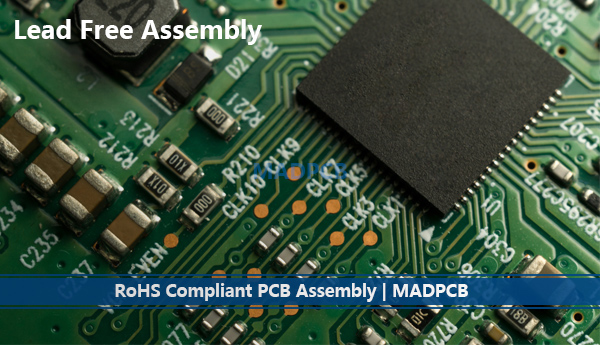Table of Contents
Lead Free (RoHS) Printed Circuit Board Assembly
Background
In February 2003, the European Union, which includes nearly 30 of 50 countries on the European continent, adopted The Restriction of Hazardous Substances Directive 200/95/EC, or RoHS 1. This directive established July 2, 2006 as the deadline for restrictions on the use of six “hazardous materials” in the manufacture of electrical and electronic devices. Compliance to the directive and its subsequent amendments (which have added four additional substances) is mandatory for European electronic manufacturers and all other countries that produce electronics products for the EU market.
As printed circuit boards (PCBs) are primary unit in virtually all electronics systems, the RoHS directive applied directly manufacturing is circuit board assembly, where RoHS compliance means replacing traditional lead-based solder with a lead-free alternative. But what does this mean for your PCB circuit board development? Before addressing this question, let’s take a look at both leaded and lead-free printed circuit board assembly. Then, you will be better prepared to decide whether you should use lead-free PCB assembly.
Leaded vs. Lead-Free Circuit Board Assembly
During the assembly of your circuit boards, the components, either SMT or thru-hole, are attached through a soldering process. For decades, most solder used for PCB assembly (PCBA) has be a tin-lead (Sn-Pb) alloy. Popular tin to lead ratios are 60/40 and 63/37, which have melting point temperatures of 188°C and 183°C, respectively. During reflow soldering, which is the preferred method for attaching SMD packages, temperatures up to 235°C may be reached as solder changes to a liquid form prior to cooling down.
Temperatures for lead free PCBA are typically higher than for Sn-Pb solder. For example, the melting point temperature for tin-silver (Sn-Ag) is 220°C for 96.5/3.5 and 240°C for 95/5, respectively. Reflow oven temperatures may peak at 250°C. These higher temperatures have implications for circuit board construction and component selection. If circuit board materials are selected with decomposition temperature that is too low, irreversible damage may occur following exposure to the elevated temperatures involved in lead free PCB assembly. Care must also be taken when choosing components to ensure there is no damage, especially during reflow where high temperatures are present on the circuit board for extended periods of time.
From a PCB manufacturing perspective, the major concern for lead free circuit board assembly is PCB damage due to higher temperatures. Rework is also more difficult. Materials are another consideration as substrates and laminates must be selected based upon their temperature attributes. Before prematurely deciding that opting for lead free circuit board is not justifiable, however, let’s explore other reasons for making the change.
You Should Use Lead Free Circuit Board If…
If any entry in the list below describes your situation, you will likely benefit from using lead free PCB assembly.
- Your products may be sold in countries that have regulatory requirements, such as the EU.
- Your state or local government mandates a lead-free circuit board and assembly manufacturing process, such as in California.
- The electronics manufacturing for your circuit boards requires that you meet regulatory standards, such as IBM and Hewlett Packard.
- You are concerns about the health risks for those who work with and use lead-based products.
- You understand the breakthroughs in smaller PCB fabrication that lead-free PCB assembly has made possible and want to promote the continued advancement in this area.
- You recognize the thrust for green electronic manufacturing and want to attract customers that place a high premium on these issues.
Today, for compliance with the RoHS Directive, you can see the hazardous substances in another article “RoHS and Lead-Free”.
Ensuring that your circuit boards are fabricated to meet the RoHS requirements means that you must ensure the contract manufacturer (CM) that you select has a defined lead-free process, including soldering, materials, components, solder mask, and surface finish. Lead free circuit board Assembly is rapidly becoming the standard for PCB fabrication. This is due to regulatory requirements, environmental concerns, and other reasons.
MADPCB is recognized as a professional and reliable electronics contract manufacturing (ECM) provider for fast, high-quality PCB prototyping and low to high volume PCB and assembly production. We utilize advanced equipment and a software-based process to manufacture circuit boards that meet your regulatory requirements. And our range of PCB capabilities and PCB assembly capabilities allow us to ensure that your PCB design objectives intent are satisfied, while providing you with the best manufacturing experience.

